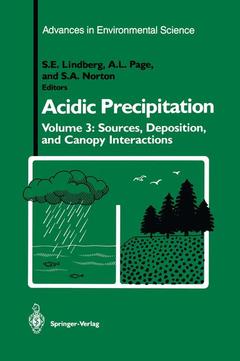Description
Acidic Precipitation, Softcover reprint of the original 1st ed. 1990
Sources, Deposition, and Canopy Interactions
Acidic Precipitation Series
Coordinators: Lindberg S.E., Page A.L., Norton S.A.
Language: English
Subjects for Acidic Precipitation:
Publication date: 07-2012
332 p. · 15.5x23.5 cm · Paperback
332 p. · 15.5x23.5 cm · Paperback
Description
/li>Contents
/li>
countries accelerating to reach a consensus on the role that atmospheric emissions and acidic precipitation play in the environment, publication of this series is timely. The editors thank the contributors to this volume for their efforts in describing a wide array of atmospheric topics, all of which are important to an understanding of the acidic precipitation issue. Oak Ridge, Tennessee Steven E Lindberg Riverside, California Albert L. Page Orono, Maine Stephen A. Norton Contents Series Preface .................................................... v Preface... ....... ...... ..... ... .. ............................... .. vii Contributors ..................................................... xiii Sources of Acids, Bases, and Their Precursors in the Atmosphere . . . 1 Roger L. Tanner I. Introduction and Definitions. . . . . . . . . . . . . . . . . . . . . . . . . . . . . . . . . . . . . . 1 II. Sources of Acids ............................................... 3 III. Sources of Acid-Neutralizing Substances (Bases) ................... 9 IV. Distribution of Atmospheric Acids and Bases ...................... 10 V. Gas-Aerosol Equilibria and Boundary Layer Mixing ................ 14 VI. Summary of Significant Acid-Formation Pathways.............. . .. . 15 References ................................?................... 17 Aerosol Sulfur Association with Aluminum in Eastern North America: Evidence for Solubilization of Atmospheric Trace Metals before Deposition ......... . . . . . . . . . . 21 . . .
Sources of Acids, Bases, and Their Precursors in the Atmosphere.- I. Introduction and Definitions.- II. Sources of Acids.- III. Sources of Acid-Neutralizing Substances (Bases).- IV. Distribution of Atmospheric Acids and Bases.- V. Gas-Aerosol Equilibria and Boundary Layer Mixing.- VI. Summary of Significant Acid-Formation Pathways.- References.- Aerosol Sulfur Association with Aluminum in Eastern North America: Evidence for Solubilization of Atmospheric Trace Metals before Deposition.- I. Statement of the Problem.- II. Approach to the Problem.- III. Results.- IV. Discussion.- References.- Source-Receptor Relationships for Atmospheric Trace Elements in Europe.- I. Introduction.- II. Emission Patterns of Atmospheric Trace Elements in Europe.- III. Long-Range Transport Models for Trace Elements in Europe.- IV. Application of Statistical Methods in Source-Receptor Studies.- V. Recommendations for Further Research.- References.- The History of Atmospheric Deposition of Cd, Hg, and Pb in North America: Evidence from Lake and Peat Bog Sediments.- I. Introduction.- II. Methods.- III. Results.- IV. Summary.- References.- Dry Deposition of Particles and Vapors.- I. Introduction.- II. The Process of Dry Deposition.- III. Wind Tunnel Studies and Semiempirical Models.- IV. Measurement Methods.- V. Dry Deposition Data and Comparison with Model Predictions.- VI. Summary.- References.- Dry Deposition of Sulfur and Nitrogen Oxide Gases to Forest Vegetation.- I. Introduction.- II. Mechanisms of Dry Deposition of Gases.- III. Experimental Measurement of Deposition.- IV. Results of Measurements of Deposition.- V. Dry Deposition and the Response of Forests.- References.- Throughfall Chemistry and Canopy Processing Mechanisms.- I. Introduction.- II. Processes That Control Throughfall Chemistry.- III. Hypothesized and Observed Throughfall Fluxes.- IV. Future Research.- Appendix: Sequential Throughfall Sampling Methods.- References.- Abatement of Atmospheric Emissions in North America: Progress to Date and Promise for the Future.- I. Introduction.- II. Acidic Rain as a Political and Technical Issue.- III. Emission Patterns.- IV. Emission Reduction Approaches for SO2 and NOx.- V. Forecasting Future Emission Trends.- VI. Cost of Emission Reductions.- VII. Policy Options for Reducing Emissions.- References.
© 2024 LAVOISIER S.A.S.
These books may interest you

Acidic PrecipitationCase Studies 52.74 €



